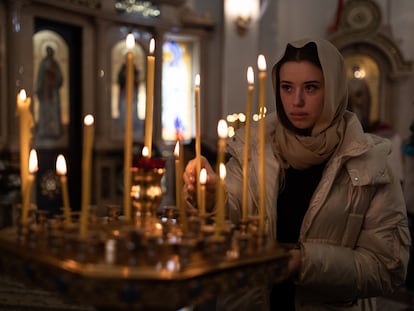The Ukraine war as of May 3: Russian and Ukrainian forces fight to control outskirts of Kharkiv
A study by Masae Analytics estimates that over 40% of infrastructure in the city has been affected by the bombing to some extent
May 3 | Combat for control of outskirts of Kharkiv
Russia’s withdrawal from northern Ukraine has turned the outskirts of Kharkiv, the country’s second-largest city, into the conflict’s northernmost front. Kharkiv is not part of the Donbas, a pro-Russian separatist region where the Kremlin is focusing its military efforts. However, there have been relentless strikes and fighting around this city of 1.5 million – most of whom are Russian speakers – since day one of the invasion. Ukrainians said they had pushed the Russians back 40 kilometers (24.9 miles) east of the city, according to the Institute for the Study of War (ISW).
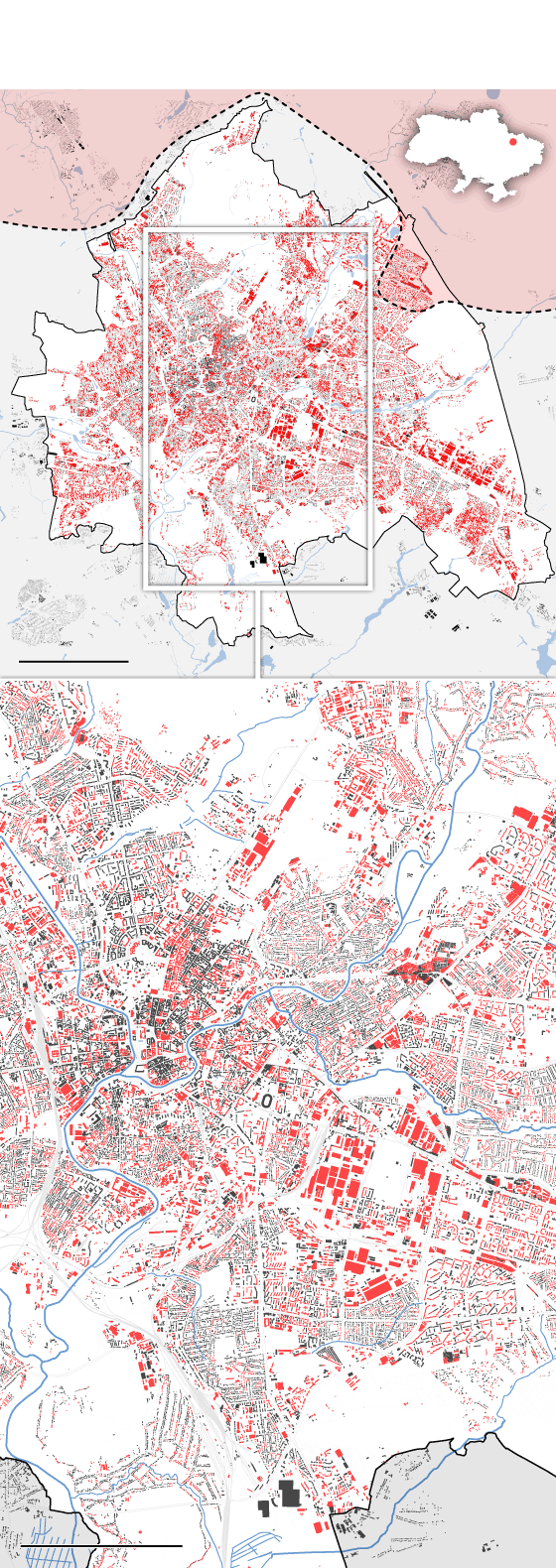
40% of Kharkiv’s buildings have sustained damage
Under Russian
control as of
March 24
KHARKIV
Detail
KHARKIV
Analyzed
area
5 km
3 km

40% of Kharkiv’s buildings have sustained damage
Kharkiv
Under Russian control
as of March 24
Analyzed area
Kharkiv
3 km
The map shows the city buildings that have sustained damage since the beginning of the conflict and up until April 17. This analysis by EL PAÍS is based on a study by Masae Analytics that estimated that over 40% of Kharkiv’s infrastructure has been affected by the bombing to some extent. Out of the 88,000 buildings under analysis, nearly 37,000 have suffered the direct consequences of the war.
In recent days, the ISW has been reporting constant bombing outside Kharkiv. On Sunday, the Ukrainian army warned about attacks in the localities of Udy and Prudyanka, north of Kharkiv and just 20 kilometers (12.4 miles) from the Russian border. The defenders have recovered territory that was occupied at the beginning of the invasion. The following maps show how Russian troops’ initial advance near Kharkiv has been lost to the counteroffensive, which gave Ukrainians control over residential areas in the north and east of the city.
On Monday, Ukraine’s Defense Minister Hanna Malyar said that Ukrainian troops had sustained significant losses during the fight to gain back control of Ruska Lozova, around 10 km north of Kharkiv. “The Ukrainian counteroffensive may unhinge the Russian positions northeast of Kharkiv and could set conditions for a broader operation to drive the Russians from most of their positions around the city,” said the ISW. “This possibility may pose a dilemma for the Russians – whether to reinforce their positions near Kharkiv to prevent such a broader Ukrainian operation or to risk losing most or all of their positions in artillery range of the city.”
A Ukrainian military spokesman said that even if the army regains key points around the city, the situation will remain volatile and that unoccupied areas will have to be cleared of landmines.
May 1 | Moving to set up permanent control
The Ukrainian government on Monday denounced “massive attacks” near the Azovstal steelworks in Mariupol. On Sunday, nearly a hundred civilians, including 20 children, were evacuated from the complex in the southern Ukrainian city, which is now almost completely under Russian control.
Russian forces were starting to set up the conditions for more permanent control over occupied areas of southern Ukraine, the ISW reported. According to this research center, Russian sources said that stores in occupied Melitopol and Volnovakha are beginning to transition to the Russian ruble. And British Defense Intelligence reported that the ruble will be used in the city of Kherson starting on May 1 as part of a four-month currency transition scheme.
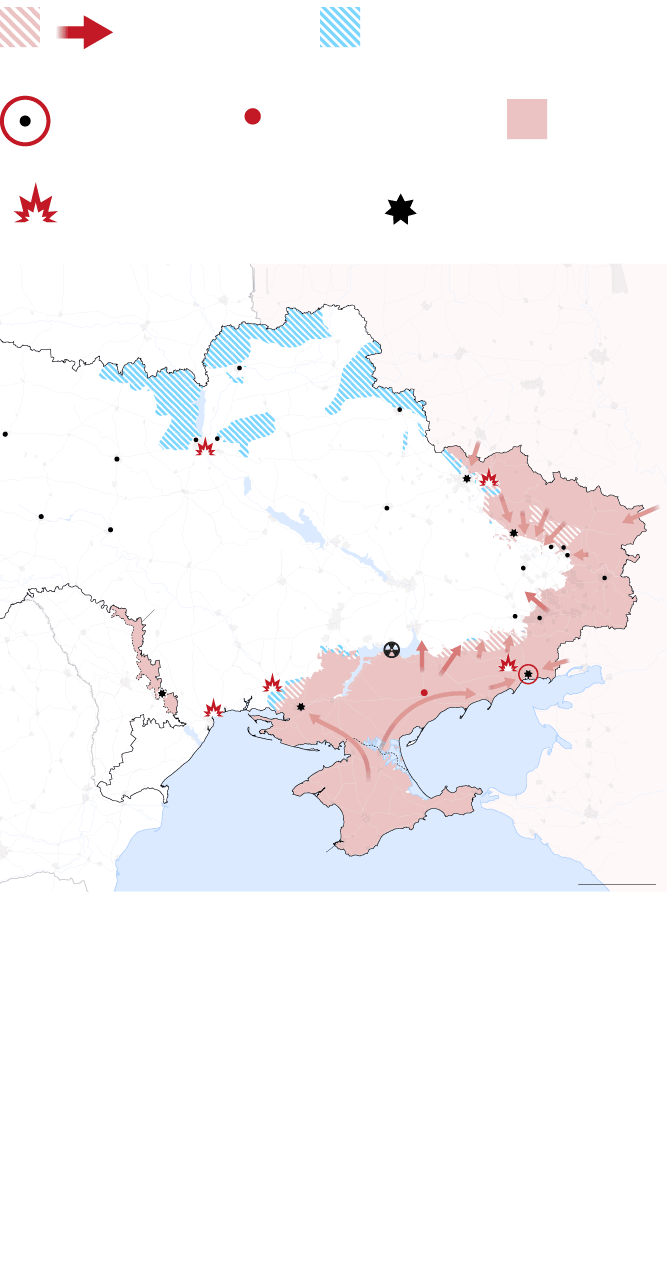
Russian
movements
Area recovered
by Ukraine
Besieged
city
City controlled
by the Russians
Russian
control
Recent
fighting
Recent
bombing
BELAURUS
Kursk
RUSSIA
Chernihiv
Sumy
Belgorod
Irpin
Brovary
Rivne
Yitomir
Kyiv
Kharkiv
Khmelnytskyi
Poltava
Vinnytsia
Izyum
Rubiyne
Kreminna
UKRAINE
Dnipro
Severodonetsk
Lugansk
TRANSNISTRIA
Kurakhivka
Krivoi Rog
DONBAS
Donetsk
Zaporizhzhia
MOLD.
Mykolaiv
Melitopol
Odessa
Mariupol
Kherson
Tiraspol
Sea of Azov
CRIMEA
Annexed by Russia
in 2014
Black Sea
250 km
Note: What does “control” mean? It requires exerting a physical influence over an area to prevent its use by the enemy. It could be achieved by occupying the area or by holding power over it with weapons. It does not imply any form of governance or legitimacy. Sources: Institute for the Study of War and American Enterprise Institute’s Critical Threats Project (for advances and areas under control); UK intelligence (besieged cities); EL PAÍS and other sources (fighting and airstrikes).

Area recovered by Ukraine
Russian movements
Russian control
Besieged city
City controlled
by the Russians
Recent
fighting
Recent
bombing
BELAURUS
Kursk
RUSSIA
Chernihiv
Sumy
Belgorod
Irpin
Brovary
Rivne
Yitomir
Kyiv
Kharkiv
Khmelnytskyi
Poltava
Vinnytsia
Izyum
Rubiyne
Kreminna
UKRAINE
Dnipro
Severodonetsk
Lugansk
TRANSNISTRIA
Kurakhivka
Krivoi Rog
DONBAS
Donetsk
Zaporizhzhia
MOLD.
Mykolaiv
Melitopol
Odessa
Mariupol
Kherson
Tiraspol
Sea of Azov
CRIMEA
Annexed by Russia
in 2014
Black Sea
250 km
Note: What does “control” mean? It requires exerting a physical influence over an area to prevent its use by the enemy. It could be achieved by occupying the area or by holding power over it with weapons. It does not imply any form of governance or legitimacy. Sources: Institute for the Study of War and American Enterprise Institute’s Critical Threats Project (for advances and areas under control); UK intelligence (besieged cities); EL PAÍS and other sources (fighting and airstrikes).
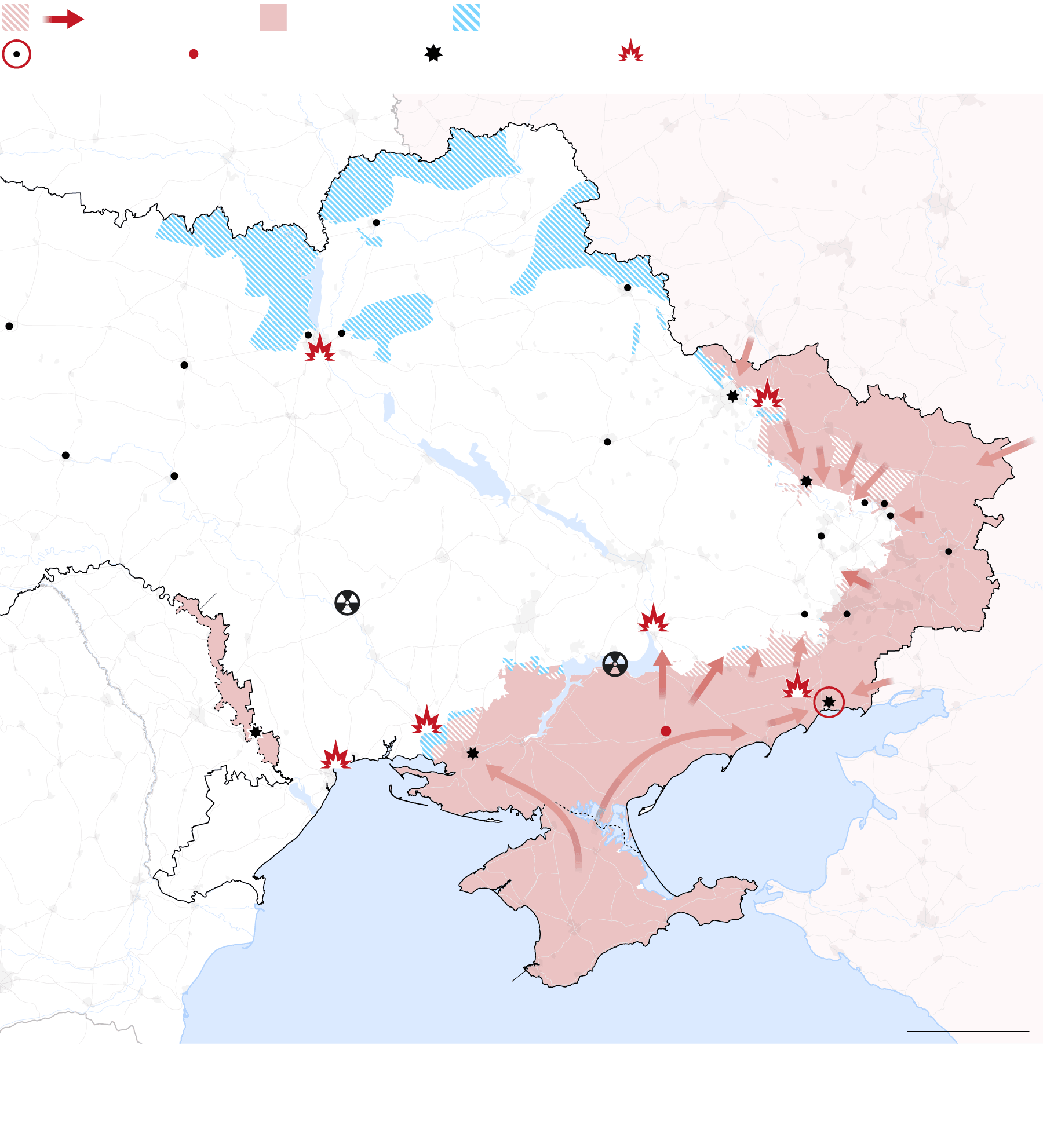
Russian movements
Area recovered by Ukraine
Russian control
Besieged city
City controlled
by the Russians
Recent
fighting
Recent
bombing
BELAURUS
Kursk
RUSSIA
Chernihiv
Sumy
Brovary
Belgorod
Rivne
Irpin
Makariv
Kyiv
Yitomir
Kharkiv
Khmelnytskyi
Poltava
Vinnytsia
Rubizhne
Izyum
UKRAINE
Kreminna
Severodonetsk
Dnipro
Sloviansk
Lugansk
TRANSNISTRIA
Zaporizhzhia
DONBAS
Kurakhivka
Krivoi Rog
Donetsk
MOLD.
Mykolaiv
Odessa
Mariupol
Melitopol
Kherson
Tiraspol
Sea of Azov
CRIMEA
Annexed by Russia
in 2014
Black Sea
250 km
Note: What does “control” mean? It requires exerting a physical influence over an area to prevent its use by the enemy. It could be achieved by occupying the area or by holding power over it with weapons. It does not imply any form of governance or legitimacy. Sources: Institute for the Study of War and American Enterprise Institute’s Critical Threats Project (for advances and areas under control); UK intelligence (besieged cities); EL PAÍS and other sources (fighting and airstrikes).
“These measures, which are not necessary or normal in military occupation administrations, indicate that Russian President Vladimir Putin likely intends to retain control over these areas and that his ambitions are not confined to Donbas,” said the ISW.
Western and Ukrainian sources claimed that Russian President Vladimir Putin may announce a “general mobilization” of the Russian military on May 9, said the ISW, which noted however that this theory is only based on statements by British Defense Minister Ben Wallace (who described it as a personal opinion) and on assertions made by Mikhail Podolyak, advisor to the Ukrainian President Volodymyr Zelenskiy.
Meanwhile, intelligence services are reporting losses among Russia’s ground and air forces. According to the UK Defense Ministry, Russia has so far committed over 120 battalion tactical groups to the invasion, approximately 65 percent of its entire ground combat strength. “It is likely that more than a quarter of these units have now been rendered combat ineffective,” said the ministry in an update.
The UK Defense Ministry also reported that some of Russia’s most elite units, including the VDV Airborne Forces, “have suffered the highest levels of attrition” and that it will probably take years for Russia to reconstitute these forces.
April 30 | Troop concentration in the southeast
The Kremlin’s forces began repositioning some of the troops besieging Mariupol’s steel plant. These troops are slated to support the offensive operations that Russia maintains in other areas of southeastern Ukraine, in the regions of Donetsk and Luhansk. The aim of this redeployment, according to the ISW, is to keep only as many troops as strictly necessary in the city of Mariupol to keep the industrial complex isolated and prevent Ukrainian sabotage, while having the largest possible combat force on the frontlines.
The Ukrainian army said last Friday that several units of the invading contingent stationed in Mariupol were on their way to Kurakhivka, located about 50 kilometers west of the city of Donetsk. This move is consistent with the Russian strategy of concentrating its forces on the eastern front and pushing back Ukrainian defenses to the border of the separatist regions of Donetsk and Luhansk. The Ukrainian defense in this area is so far succeeding in slowing, if not stopping, the Russian advance west of the town of Severodonetsk and in the vicinity of Izyum. Despite resistance, Russian forces are shelling relentlessly along the entire eastern frontline of the conflict. In recent days they have managed to secure new positions (on Friday, in Yampil, west of Severodonetsk) and force the defenders to constantly move the defensive line to evade attacks.
In the south, in the Kherson region, the invading forces did not carry out ground operations on Friday, concentrating on improving their positions in an area that’s been targeted by Ukrainian counterattacks. Kremlin forces did shell numerous towns in Kherson, Zaporizhzhia and Mykolaiv.
April 28 | False flag attacks in Transnistria
Explosions in Transnistria, a separatist, pro-Russian region of Moldova, are fueling fears that the Kremlin’s offensive could spill beyond the borders of Ukraine. On Monday, a Security Ministry building in Tiraspol, the capital of the unrecognized republic, was attacked with grenade launchers. On Tuesday there were blasts that damaged radio antennas in Maiac, and a strike against a military unit near Parcani. On Wednesday, local authorities reported attacks from Ukrainian territory against a weapons and ammunition depot housing thousands of tons of Soviet-era equipment in the town of Cobasna. The government of Moldova attributed the attacks to “internal forces that seek to provoke a war and destabilize the situation.” The Institute for the Study of War (ISW) considers these false flag attacks conducted either by Russian forces or by sympathizers of the Kremlin who are seeking to create the right conditions to justify new operations in the area, or else to destabilize Moldova.
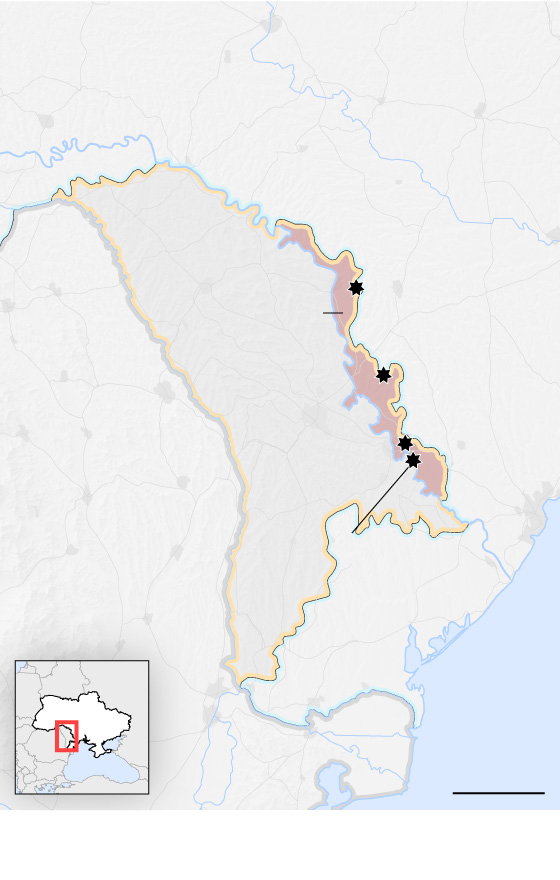
UKRAINE
Dniester River
Shots from the
Ukraine border
Transnistria
Communication
towers
MOLDOVA
Iași
Chisinau
ROMANIA
Attack against
a military unit
Tiraspol
Bacău
Odessa
Security
Ministry
Black
Sea
60 km
Source: Interior Ministry and Security Council of Transnistria, TASS
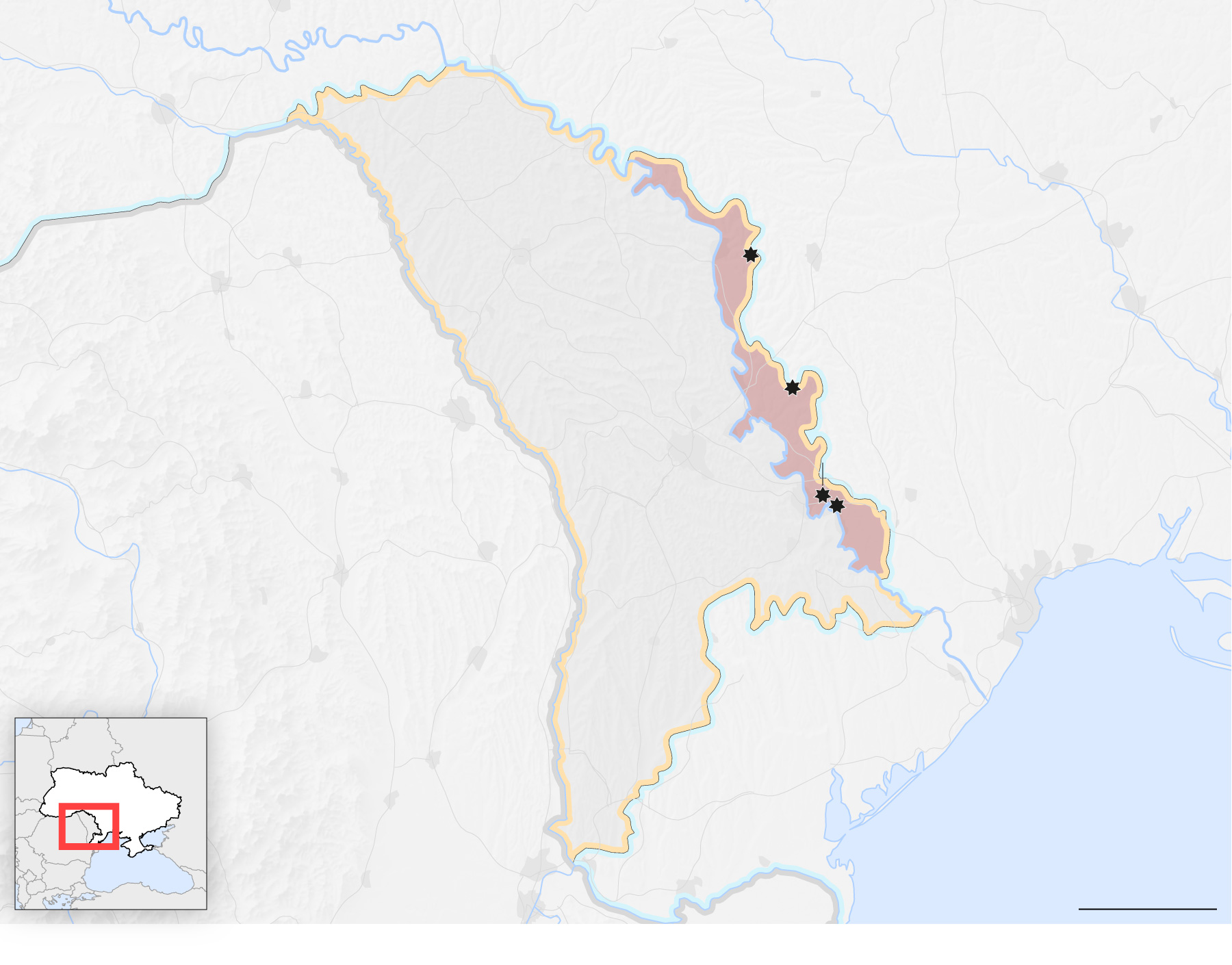
Buh River
Chernovtsi
UKRAINE
Shots from the
Ukraine border
Dniester River
Transnistria
Prut River
MOLDOVA
Attack against
communication towers
Iași
Attack against
a military unit
Chisinau
Tiraspol
ROMANIA
Security
Ministry
Bacău
Odessa
Black Sea
60 km
Source: Interior Ministry and Security Council of Transnistria, TASS
The attacks would serve as a pretext for Moscow to allegedly safeguard its Russian-speaking population in the east, where the Kremlin has had forces deployed for three decades. This same pretext was used in the eastern Ukrainian provinces of Donetsk and Luhansk when Russian President Vladimir Putin ordered his troops to invade Ukraine. The ISW believes that Russia does not have enough battalions in the area to launch an attack against the city of Odessa, and cannot benefit from reinforcements because they lack access to the areas that are under their control. A study by the Brussels-based think tank CEPS claims that there are nearly 1,500 Russian soldiers deployed on a stretch of land of around 400 kilometers along the eastern bank of the Dniester River. A third of them are there as keepers of the peace, and the rest are there to watch over the Cobasna arsenal, one of the biggest in eastern Europe.
If Russia were to recognize Transnistria, which officially calls itself the Pridnestrovian Moldavian Republic, it would allow separatists there to seek additional protection from the Kremlin. Getting Transnistria involved in the conflict would let Russia launch attacks from that territory, and would increase tensions between Moldova and neighboring Romania, which is a member of NATO. While Moldova is not a member, it is a close collaborator and regularly attends meetings.
The Russian general Rustam Minnekayev said last week that Moscow is targeting “the vital centers of the Ukrainian economy” and wants access to Transnistria, where he claims there have been “cases of oppression against the Russian-speaking population.” The ISW has warned that Russian and Transnistrian forces on Wednesday accelerated preparations for potential operations. And Ukrainian intelligence sources cautioned that they could be preparing a missile strike in order to blame it on Kyiv. A study by the Center for Strategic and International Studies conducted before the start of the invasion foresaw the possibility of a Russian conquest of a strip of territory connecting Crimea (which Russia annexed in 2014) with the Donbas region of Ukraine and Transnistria.
April 26 | Russia puts pressure on the east
Russian forces are trying to surround Ukrainian defensive lines in the east, according to UK intelligence reports. Russian advances from Izyum in the north and Mariupol in the south would squeeze the Ukrainian fighters who have been repelling the invader for weeks on the Donbas front. Moscow’s ground operations have barely secured any new territory in the last 24 hours, according to the Institute for the Study of War (ISW). The Ukrainians’ easternmost defensive position is near the town of Severodonetsk; if the Russians manage to fully encircle them from behind, they will be trapped and unable to receive supplies.
“The city of Kreminna has reportedly fallen and heavy fighting is reported south of Izyum, as Russian forces attempt to advance towards the cities of Sloviansk and Kramatorsk from the north and east. Ukrainian forces have been preparing defenses in Zhaporizhia ahead of a potential Russian attack from the south,” said the UK Defense Ministry in its update.
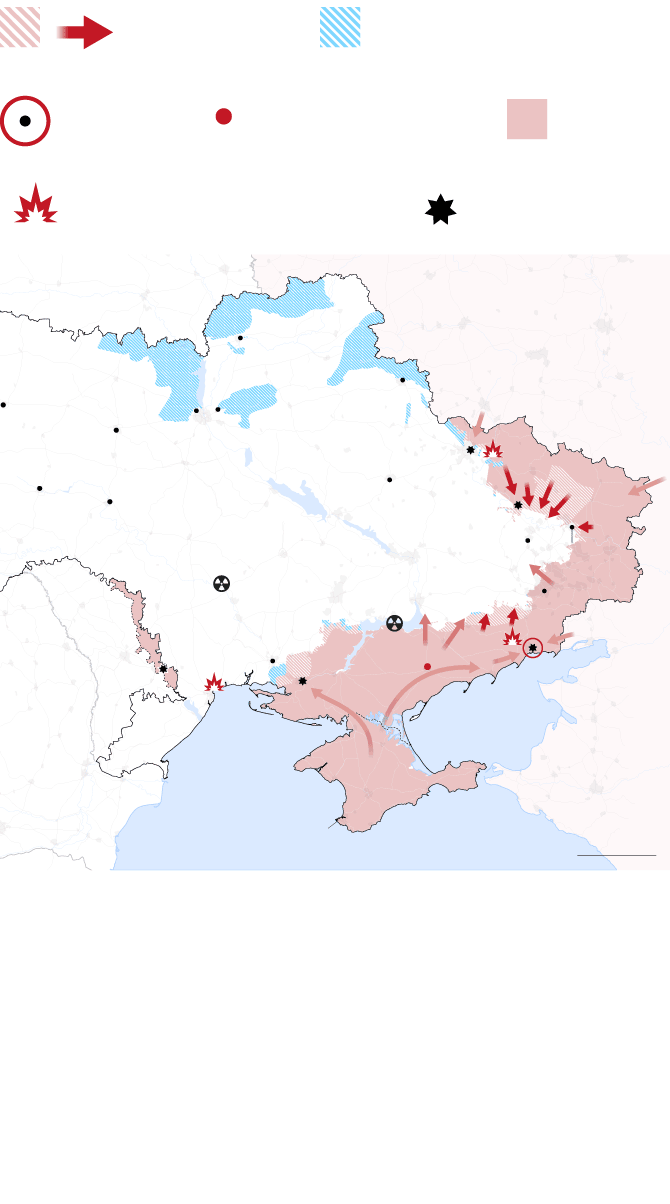
Russian
movements
Area recovered
by Ukraine
Besieged
city
City controlled
by the Russians
Russian
control
Recent
fighting
Recent
bombing
BELAURUS
Kursk
RUSSIA
Chernihiv
Sumy
Belgorod
Rivne
Brovary
Yitomir
Kharkiv
Khmelnytskyi
Poltava
Izyum
Vinnytsia
Kramatorsk
Kyiv
Severodonetsk
DONBAS
Zaporizhzhia
Donetsk
Transnistria
MOLD.
Mykolaiv
Melitopol
Odessa
Mariupol
Kherson
Sea of Azov
CRIMEA
Annexed by Russia
in 2014
250 km
Black Sea
Note: What does “control” mean? It requires exerting a physical influence over an area to prevent its use by the enemy. It could be achieved by occupying the area or by holding power over it with weapons. It does not imply any form of governance or legitimacy. Sources: Institute for the Study of War and American Enterprise Institute’s Critical Threats Project (for advances and areas under control); UK intelligence (besieged cities); EL PAÍS and other sources (fighting and airstrikes).

Area recovered by Ukraine
Russian movements
Russian control
Besieged city
City controlled
by the Russians
Recent
fighting
Recent
bombing
BELAURUS
Kursk
RUSSIA
Chernihiv
Sumy
Irpin
Rivne
Belgorod
Brovary
Kyiv
Yitomir
Kharkiv
Khmelnytskyi
Poltava
Vinnytsia
Izyum
Rubizhne
Kreminna
Dnipro
Kramatorsk
Severodonetsk
UKRAINE
Lugansk
Krivoi Rog
Zaporizhzhia
DONBAS
Donetsk
Nuclear power plant
Transnistria
MOLD.
Mykolaiv
Melitopol
Mariupol
Kherson
Sea of Azov
CRIMEA
Annexed by Russia
in 2014
Black Sea
250 km
Note: What does “control” mean? It requires exerting a physical influence over an area to prevent its use by the enemy. It could be achieved by occupying the area or by holding power over it with weapons. It does not imply any form of governance or legitimacy. Sources: Institute for the Study of War and American Enterprise Institute’s Critical Threats Project (for advances and areas under control); UK intelligence (besieged cities); EL PAÍS and other sources (fighting and airstrikes).
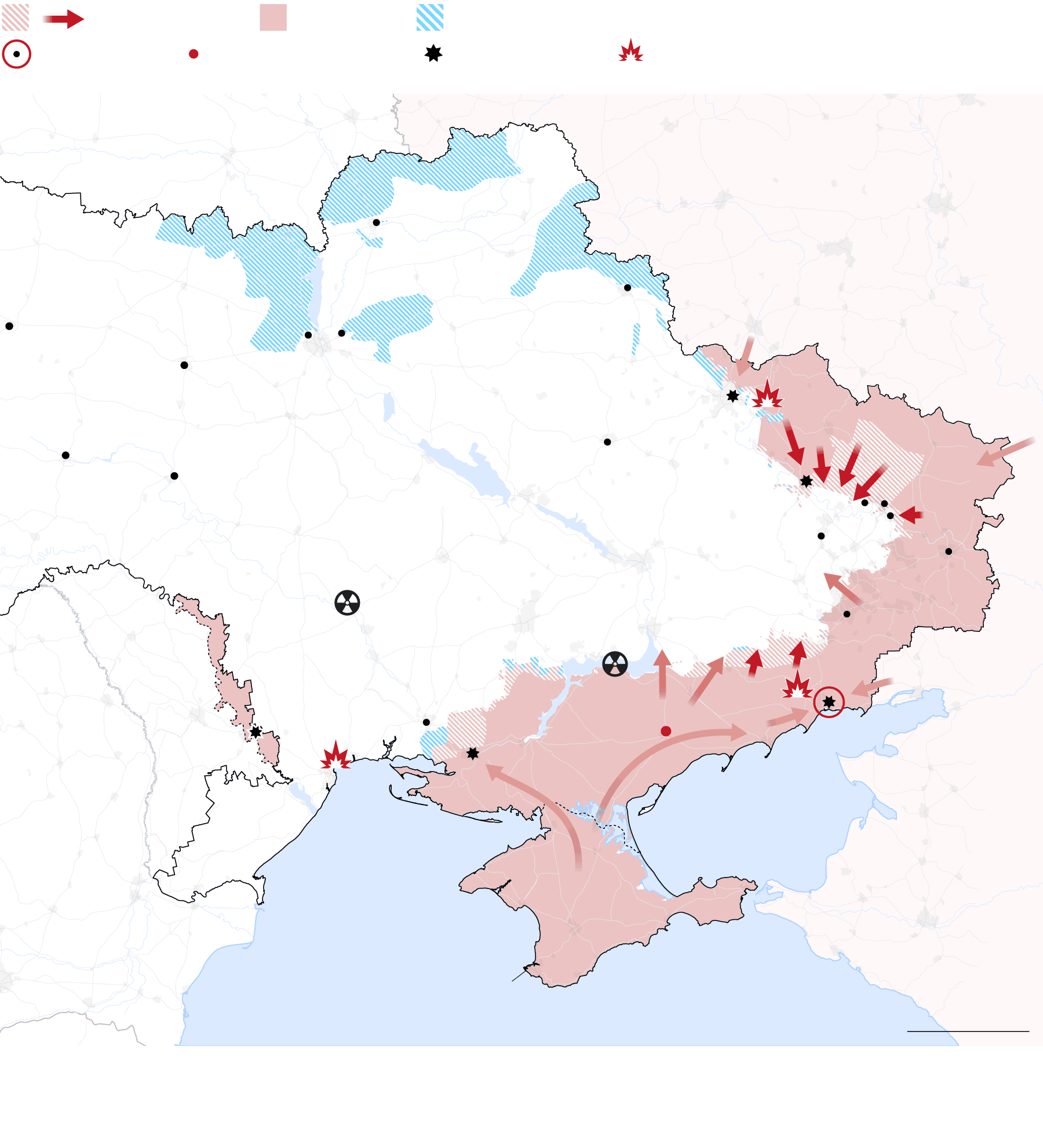
Russian movements
Area recovered by Ukraine
Russian control
Besieged city
City controlled
by the Russians
Recent
fighting
Recent
bombing
BELAURUS
Kursk
RUSSIA
Chernihiv
Sumy
Belgorod
Irpin
Brovary
Rivne
Kyiv
Yitomir
Kharkiv
Poltava
Khmelnytskyi
Vinnytsia
Izyum
Rubizhne
UKRAINE
Kreminna
Dnipro
Severodonetsk
Kramatorsk
Lugansk
DONBAS
Zaporizhzhia
Krivoi Rog
Donetsk
Nuclear power plant
MOLD.
Mykolaiv
Melitopol
Odessa
Mariupol
Tiraspol
Kherson
Sea of Azov
CRIMEA
Annexed by Russia
in 2014
Black Sea
250 km
Note: What does “control” mean? It requires exerting a physical influence over an area to prevent its use by the enemy. It could be achieved by occupying the area or by holding power over it with weapons. It does not imply any form of governance or legitimacy. Sources: Institute for the Study of War and American Enterprise Institute’s Critical Threats Project (for advances and areas under control); UK intelligence (besieged cities); EL PAÍS and other sources (fighting and airstrikes).
The ISW’s daily report drew attention to May 9, the day when Russia will hold a Victory Day parade to observe the 77th anniversary of the defeat of Nazi Germany. This red-letter day on the Kremlin’s calendar could be behind the renewed ground attacks against the Azovstal steel plant in Mariupol, the last remaining stronghold of resistance in the port city. The ISW notes that Russian officials in charge of the operation might feel that the strategy of besieging the plant may not be enough to starve out the defenders ahead of May 9.
In the south, Ukrainian defense forces conducted counterattacks to take back control of an area between the city of Kherson, which is under Russian occupation, and Mykolaiv. “Local Ukrainian counterattacks in Kherson Oblast are unlikely to develop into a larger counteroffensive in the near term but are disrupting Russian efforts to completely capture Kherson Oblast and are likely acting as a drain on Russian combat power that could otherwise support Russia’s main effort in eastern Ukraine,” said the ISW.
In western and central Ukraine, Russian troops conducted precision missile strikes against five Ukrainian railway stations. The strikes, which took place within the space of an hour, killed at least one person and injured more than 40 in Vinnytsia, Poltava, Khmelnytskyi, Rivne and Zhytomyr oblasts. Ukrainian military commanders said the attack sought to disrupt Western weapons supplies to Ukraine.
The self-proclaimed authorities in the separatist region of Transnistria, (Russia’s occupied territory in Moldova), said that a government building in the capital, Tiraspol, was attacked on Monday with grenade launchers. Before dawn on Tuesday, two relay antennae were destroyed. No victims were reported in either case. Ukrainian authorities depicted the incident as a false flag attack conducted by Russian forces. Moscow said the new goal of its offensive in Ukraine was also to gain access to this Moldovan region located along the border with southern Ukraine, and which has been trapped for years in the Cold War. Russia has not recognized its independence and keeps around 1,000 soldiers in the area in charge of watching over old munitions deposits dating back to Soviet times.
April 25 | Russia is incapable of launching a decisive attack
The Russian offensive in Ukraine, focused for weeks in the southeast, has barely altered the frontline in recent days. Small, scattered operations throughout the Russian control line have allowed the invading forces to make very limited gains – for example near Severodonetsk, a city of 100,000 residents in eastern Ukraine. In the past week, the Russians have gained around 10 kilometers (6.2 miles) north of Melitopol, in the south. The ISW believes that the Kremlin’s troops are still incapable of launching a decisive offensive operation, as they have failed to make a technical stop to regroup the units that withdrew from the north.
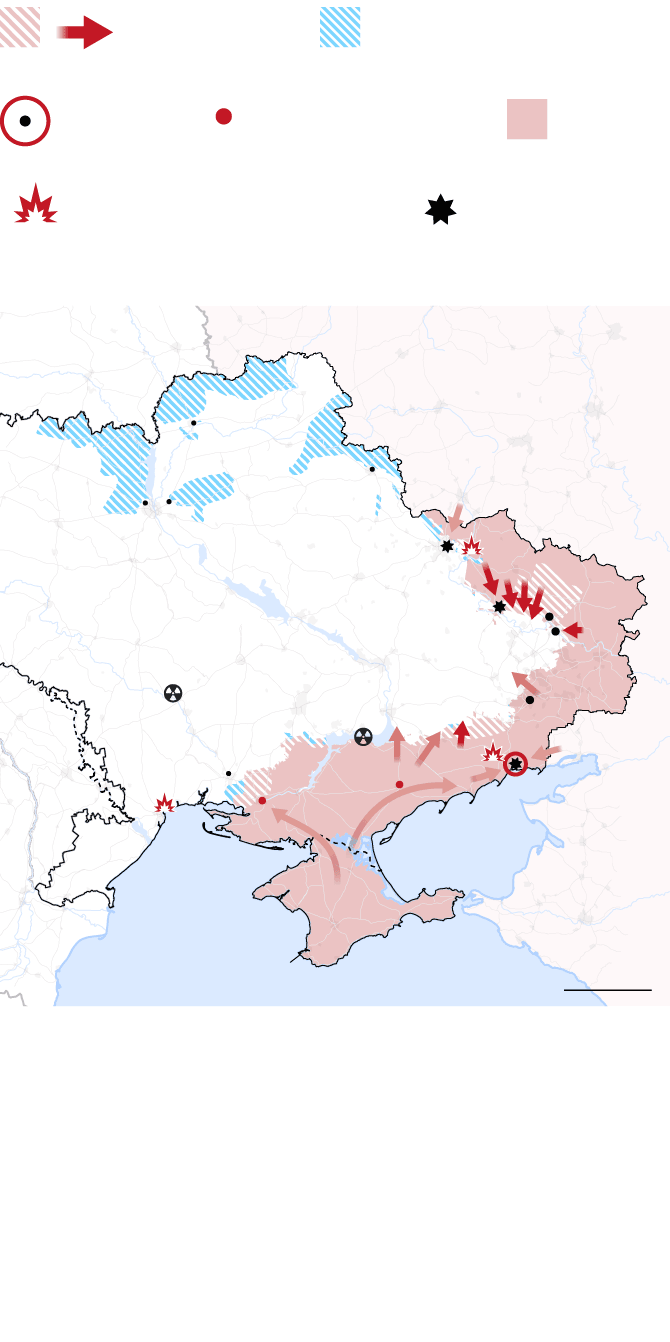
Russian
movements
Area recovered
by Ukraine
Besieged
city
City controlled
by the Russians
Russian
control
Recent
fighting
Recent
bombing
BELAURUS
Kursk
RUSSIA
Chernihiv
Sumy
Irpin
Brovary
Belgorod
Makariv
Kyiv
Kharkiv
Severo-
donetsk
Izyum
UKRAINE
Sloviansk
Popasna
DONBAS
Zaporizhzhia
Donetsk
Mykolaiv
MOLD.
Melitopol
Odessa
Mariupol
Kherson
Berdiansk
Sea of Azov
CRIMEA
Annexed by Russia
in 2014
Black Sea
250 km
Note: What does “control” mean? It requires exerting a physical influence over an area to prevent its use by the enemy. It could be achieved by occupying the area or by holding power over it with weapons. It does not imply any form of governance or legitimacy. Sources: Institute for the Study of War and American Enterprise Institute’s Critical Threats Project (for advances and areas under control); UK intelligence (besieged cities); EL PAÍS and other sources (fighting and airstrikes).
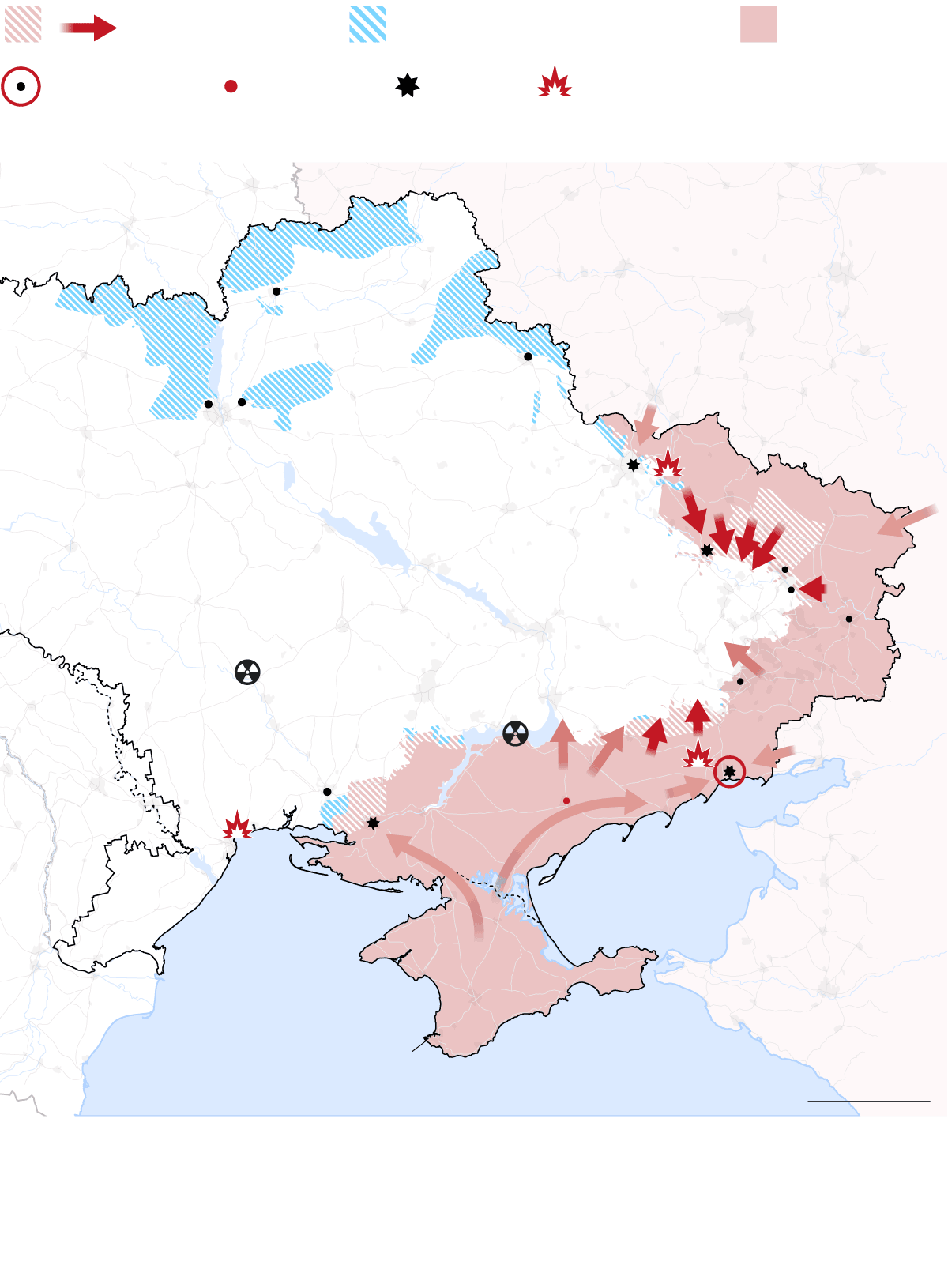
Area recovered by Ukraine
Russian movements
Russian control
Besieged city
City controlled
by the Russians
Recent
fighting
Recent
bombing
BELAURUS
Kursk
RUSSIA
Chernihiv
Sumy
Irpin
Brovary
Belgorod
Makariv
Yitomir
Kyiv
Kharkiv
Izyum
Rubizhne
UKRAINE
Severo-
donetsk
Sloviansk
Lugansk
Dnipro
Popasna
DONBAS
Krivoi Rog
Zaporizhzhia
Donetsk
Nuclear power plant
Mykolaiv
MOLD.
Melitopol
Kherson
Odessa
Mariupol
Berdiansk
Sea of Azov
CRIMEA
Annexed by Russia
in 2014
Black Sea
250 km
Note: What does “control” mean? It requires exerting a physical influence over an area to prevent its use by the enemy. It could be achieved by occupying the area or by holding power over it with weapons. It does not imply any form of governance or legitimacy. Sources: Institute for the Study of War and American Enterprise Institute’s Critical Threats Project (for advances and areas under control); UK intelligence (besieged cities); EL PAÍS and other sources (fighting and airstrikes).
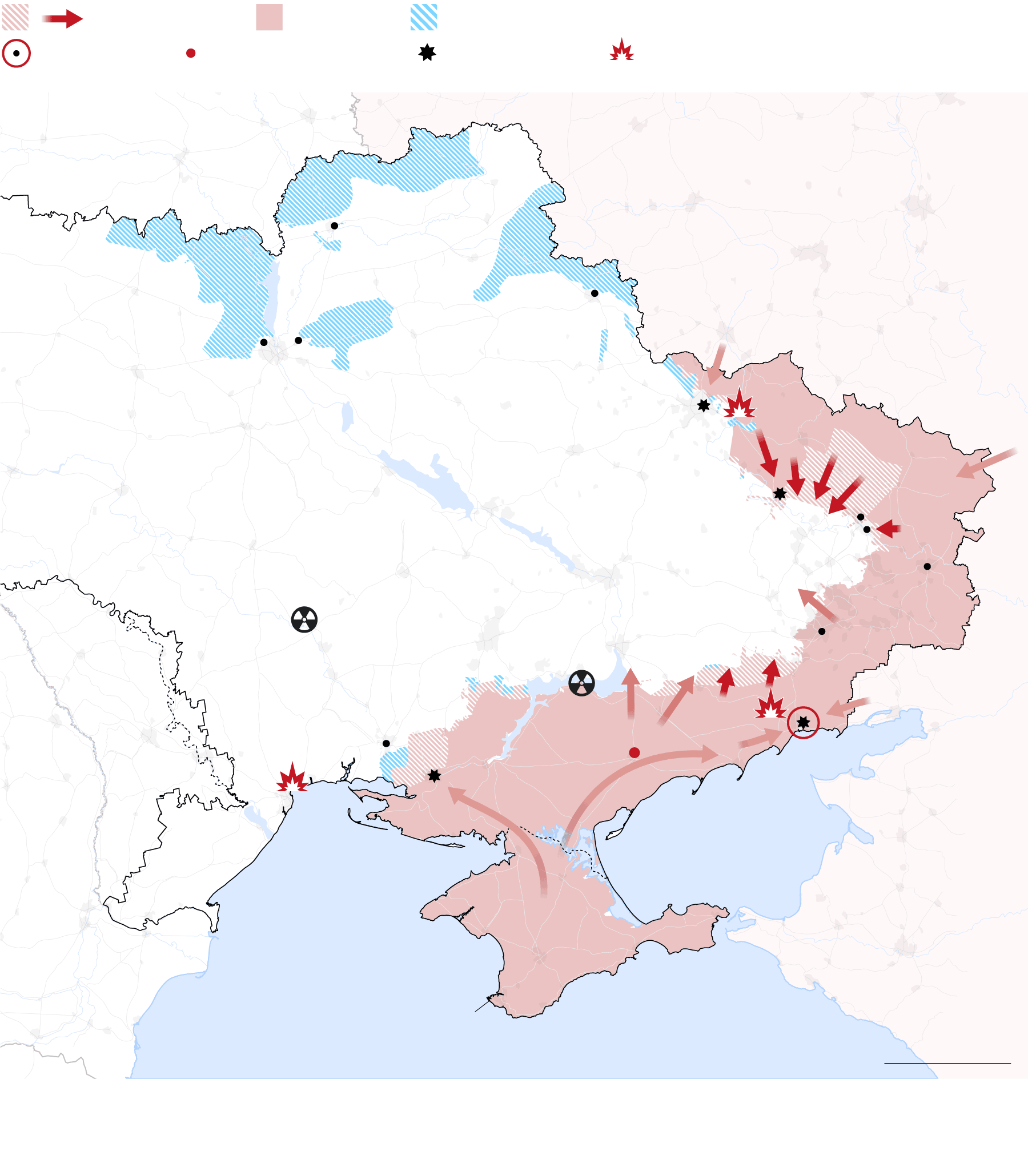
Russian movements
Area recovered by Ukraine
Russian control
Besieged city
City controlled
by the Russians
Recent
fighting
Recent
bombing
BELAURUS
Kursk
RUSSIA
Chernihiv
Sumy
Brovary
Belgorod
Irpin
Makariv
Yitomir
Kyiv
Kharkiv
Izyum
UKRAINE
Rubizhne
Severodonetsk
Sloviansk
Dnipro
Popasna
Lugansk
DONBAS
Krivoi Rog
Zaporizhzhia
Donetsk
Nuclear power plant
Mykolaiv
MOLD.
Melitopol
Odessa
Kherson
Mariupol
Berdiansk
Sea of Azov
CRIMEA
Annexed by Russia
in 2014
Black Sea
250 km
Note: What does “control” mean? It requires exerting a physical influence over an area to prevent its use by the enemy. It could be achieved by occupying the area or by holding power over it with weapons. It does not imply any form of governance or legitimacy. Sources: Institute for the Study of War and American Enterprise Institute’s Critical Threats Project (for advances and areas under control); UK intelligence (besieged cities); EL PAÍS and other sources (fighting and airstrikes).
In Mariupol, Russian forces continued to put a stranglehold on combatants and civilians who took refuge at the Azovstal steel plant, which was targeted throughout Sunday. The Russian strategy of besieging the plant means that many troops are focused there and cannot be sent elsewhere on missions such as advancing towards the north to isolate Ukrainian soldiers who continue to hold out in the Donbas region, said UK intelligence reports.
Ukrainian defense sources cited by the ISW said the invading forces appeared to be preparing an attack on the steel plant, because the Kremlin wants to show off its capture of Mariupol on May 9, when it is scheduled to hold a Victory Day military parade to observe the defeat of Nazi Germany 77 years ago.
Ukrainian president Volodymir Zelenskiy on Sunday received a visit from US State Secretary Antony Blinken and Defense Secretary Lloyd Austin. Authorities announced that the US embassy will reopen in Kyiv.
